Fighting Against Climate Change
Climate change is a major global issue for all humankind. As a responsible energy and petrochemical company, Sinopec regards it as its due responsibility to fight against climate change. We make efforts to shift the pattern of growth, optimize energy structure, develop and utilize low-carbon energy resources and promote energy saving and consumption reduction. We are speeding up study on commercial test of CO2 recovering, in order to reduce GHG emissions and better prepare to combat climate change.
Industrial Restructuring and More Efficient Use of Energy Resources
We continued our efforts in industrial restructuring and integrating production capacities and operations. Energy and material consumption went down considerably and there were less CO2 emission.
On the one hand, we increased and integrated production capacities by building up new facilities and expanding and upgrading existing ones. In 2011, the Changling chemical revamping project came on stream. By the end of 2011, we have 11 10 mtpa refineries and 10 large-scale ethylene production bases.
On the other hand, we increased average production capacities and cut down consumption by phasing out small and inefficient capacities. From 2006 to 2011, we shut down and phased out small and less environment-friendly refining capacities by 16.2 mtpa. Dozens of small chemical facilities and oil-fired boilers were closed. Optimization and volume adjustment were made to more than 500 oil tank farms.
With the above parallel measures, average capacity of our refineries rose by 25.7% and that of ethylene facilities went up by 13.2% from 2006 to 2011.
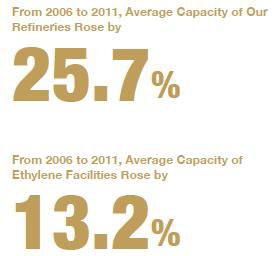
Saving Energy and Cutting CO2 Emission
Saving energy is the most immediate and effective way to reduce CO2 emission at present. Giving priority to conservation, we try to develop into a resource-efficient enterprise.
For many years, while the production capacities kept growing, Sinopec achieved good results in energy saving and consumption cut with enhanced management, new technologies and equipments, and special emphasis on energy saving in production process. In 2011, the comprehensive energy consumption per unit of GDP dropped by 1.54%. Energy intensity of refining and ethylene production went down respectively by 2.0% and 4.3%. We save 1.36 million tons of standard coal equivalent, which equals cutting 3.35 million tons of CO2 emissions or planting 30 million trees (a thirty-year-old fir absorbs 111 kg of CO2).
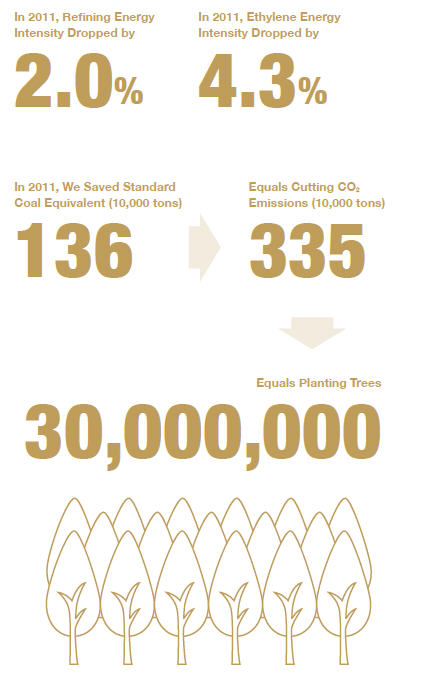
We made important progress in water saving with measures for leak checking and fixing, condensate recovery, utilization of low temperature residual heat and reuse of waste water. In 2011, Sinopec continued to promote water conservation and emission reduction. Major indicators were included in economics accountability assessment. Compared with last year,industrial water withdrawal went down by 1.95%, and water withdrawal per ton of crude oil processed dropped by 7.69%. In 2011, we saved a total of 19.95 million tons of water, which is 1.4 times of the volume of the West Lake (14.29 million m3).
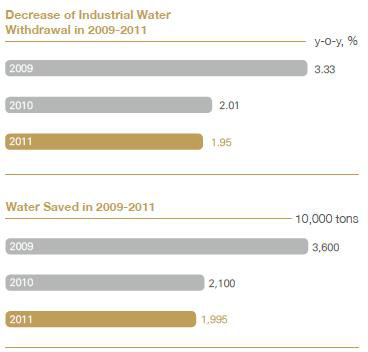
Developing Low-Carbon Energy and Optimizing Energy Structure
Sinopec is active in developing low-carbon energy and improving energy structure. A complete low-carbon energy business chain covering R&D, industrial production and marketing has taken shape. Our plan is to build up low-carbon energy capacities by 2020 that can supplement main business operations and contribute to long-term and sustainable development of the company.
We strive to increase natural gas production and facilitate LNG import. In 2011, we produced 15.6 billion m3 of natural gas at home and abroad, signed new LNG procurement agreements totaling 4.3 million tpa, started construction of Shangdong LNG project, and kicked off initial work of LNG projects in Guangxi, Tianjin, Lianyungang, Wenzhou and Huangmao Island.
We make great efforts in developing coal-bed methane (CBM) and shale gas. In 2011, we made firm progress in shale gas E&P, and fixed capacity building locations for CBM.
We devote major efforts in producing natural gas from coal. We are speeding up preliminary work for coal to natural gas and pipeline projects in Xinjiang. We have also started the first phase of the coal-electric power-chemicals integrated project in Zhijin, Guizhou.
Bioethanol consumption and sales are expanding. In 2011, we used 910,000 tons of modified fuel ethanol and sold 9.1 million tons of ethanol gasoline.
Since November 2010, we have started pilot sales of B5 biodiesel in Chengmai County and Lingao County, Hainan Province. In 2011, we sold 4,000 tons of B5 biodiesel and used 200 tons of B100 biodiesel.
Geothermal energy development expanded in scale. By the end of 2011, we have gained the exclusive development right of geothermal blocks totaling over 300 km2 and realized 6 million m2 of geothermal heating area, accounting for 15% of China's total. The geothermal heating capacity in Xiong County, Hebei Province and Xianyang, Shaanxi Province, accounts for 90% and 25% of centralized heating capacity locally. With bigger scale of geothermal usage, we can save 360,000 tons of standard coal equivalent and cut CO2 emission by 890,000 tons every year.
E-power service station. We plan to establish refilling and recharging service networks in 13 provinces and cities for both regular autos and electric autos. By far, we have built up 2 recharging stations in Beijing and Shenzhen, and 6 refilling and recharging demo stations in Shanghai and Anhui.
More Efforts in R&D to Fight Against Climate Change
Our objective is to enhance our ability of low-carbon growth by reinforcing our mid-term and long-term strategic low-carbon technology preparation. We plan to focus on R&D of technologies that help with energy saving and efficiency improvement, development of renewable and alternative energy sources, emission control, treatment and utilization of GHG like CO2 and CH4, biological and engineering carbon sequestration, clean and efficient development and utilization of coal, oil and natural gas, CO2 capturing and sequestration, CO2 flooding, comprehensive utilization of high purity CO2 and fuel production via microalgal CO2 fixation.
Low-Carbon Lifestyle
To preserve and ameliorate the environment is regarded by Sinopec as an important social responsibility and a major way to improve production and living conditions for employees. Aiming to build up a garden-like energy company, we motivate our staff to take part in activities for public good like national mandatory tree-planting campaign. In 2011, 520,000 person times in Sinopec took part in the campaign, planted 1.56 million trees, and thus 90% of our tree-planting obligations fulfilled.
We spread information about climate change among employees, consumers, suppliers, contractors and other stakeholders, calling for changes in mode of production, way of life and habit of consumption, and for stronger sense of social responsibility and keener awareness to protect the environment.
We only purchase materials and equipments in conformity with green, energy-saving and low-carbon standards. In this way, we are trying to lead our suppliers and contractors on the right track of green and low-carbon growth.
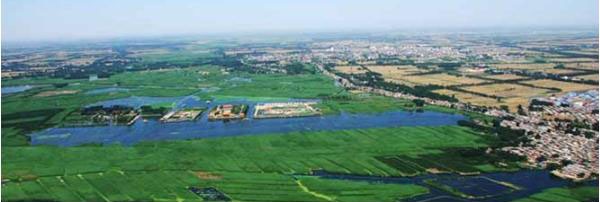

 Address
Address Post code
Post code Tel
Tel
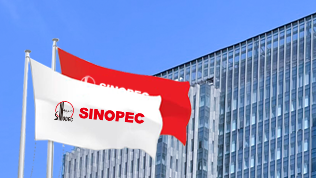



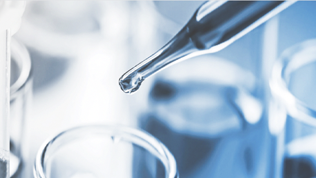





 京公网安备11010502035639
京公网安备11010502035639